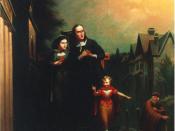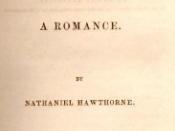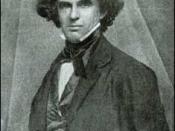The Scarlet Letter by Nathaniel Hawthorne, very clearly demonstrates many aspects of sin. It was set in Puritan Boston where sin was to be punished, not forgiven. There was no mercy or grace. Through Hester Prynne cheating, the lies of Arthur Dimmesdale, and the evil that Roger Chillingsworth bestows upon Dimmesdale, Hawthorne reveals the torturous nature of sin.
One of the most blatant examples of sin in the characters is of Roger Chillingsworth. Throughout the novel, Chillingsworth tortures Dimmesdale endlessly and is clearly the cruelest character. In chapter 9, "The Leech", he says to Dimmesdale, "I could be well content, that my labors, and my sorrows, and my sin, and my pains, should shortly end with me, and what earthly of them be buried my grave, and the spiritual go with me to my eternal state, rather than that you should put your skill to the proof in my behalf."
(Hawthorne 85) Through Roger Chillinsgworth's words and actions, we see him as an unhappy man who cares only about himself, not for the well being of others.
Another example of sin portrayed in The Scarlet Letter, is the obvious sin of Hester Prynne. Although she is a very sweet woman who helps people in need, even more than she helps herself, she has still committed the horrible sin of adultery. Because of the wrong she had committed, she was forcibly placed in front of the community so that everyone would know what she had done. Chapter 9 also describes the situation that occurred saying, ""æthe crowd that witnessed Hester Prynne's ignominious exposure"æbeheld the woman, in whom he hoped to find embodied the warmth and cheerfulness of home, set up as a type of sin before the people"æ" (Hawthorne 82) Unlike Chillingsworth, whose sin was not on public display, Hester had to deal with everyone's outward disgust of her as a person. Chapter 13 says, "Her only justification lay in the fact that she had been able to discern no method of rescuing Dimmesdale except by acquiescing in Roger Chillingsworth's scheme of disguise"æShe determined to redeem her error, so far as it might yet be possible. Strengthened by years of hard and solemn trial, she felt herself no longer so inadequate to cope with Roger Chillingsworth as on that night, abased by sin"æ." (Hawthorne 116) Reverend Arthur Dimmesdale carried an extremely heavy, silent sin throughout most of the novel. There were only four people who knew of his secret guilt. Only Hester, Chillingsworth, God, and he himself knew that he, the minister of the town, was the father of Hester's daughter, Pearl. Chapter 11, "The Interior of a Heart", says of Dimmesdale, "He had striven to put a cheat upon himself by making the avowal of a guilty conscience, but had gained only the other sin, and a self acknowledged shame, without the momentary relief of being self-deceived. He had spoken the very truth and transformed it into the veriest falsehood. And yet, by the constitution of his nature, he loved the truth, and loathed the lie, as a few men ever did. Therefore, above all things, he loathed his miserable self!" (Hawthorne 100-101) Dimmesdale's concealment of his sin was killing him. He knew the only way to be forgiven, was to confess.
As is evidently stated through the examples of sin in The Scarlet Letter, Nathaniel Hawthorne was successful in conveying his theme of "Sin" to the reader. Although the novel was full of illustrations where sin was present, Hawthorne was careful to include the act of forgiveness and mercy as well. Chapter 17 states, " I do forgive you, Hester"æI freely forgive you now. May God forgive us both! We are not, Hester, the worst sinners in the world."





